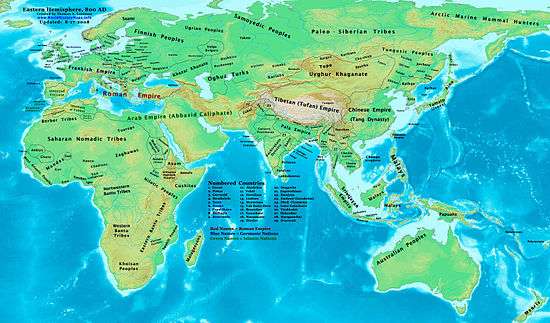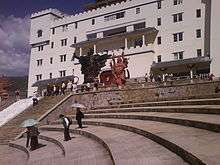Nanzhao
| 南詔國 | ||||||||
| Kingdom | ||||||||
| ||||||||
| Capital | Taihe | |||||||
| Religion | Buddhism | |||||||
| Government | Monarchy | |||||||
| History | ||||||||
| • | Established | 738 738 | ||||||
| • | Duan Siping overthrew Nanzhao | |||||||
| • | Ended by the Dali Kingdom | 937 937 | ||||||
| ||||||||
| Warning: Value not specified for "common_name" | ||||||||

Nanzhao, alternate spellings Nanchao and Nan Chao (simplified Chinese: 南诏; traditional Chinese: 南詔; pinyin: Nánzhào; Thai: น่านเจ้า; Standard Tibetan: Jang[1]) was a polity that flourished in what is now southern China and Southeast Asia during the 8th and 9th centuries. It was centered on present-day Yunnan in China.
Founding and ethnography
Nanzhao comprised many ethnic and linguistic groups. Some historians believe that the majority of the population were of the Bai people,[2] but that the elite spoke a variant of Nuosu (also called Yi), a Tibeto-Burman language closely related to Burmese.[3]
Originally, there were several tribes that settled on the fertile land around the alpine fault lake Erhai. These tribes were called Mengshe (蒙舍), Mengsui (蒙嶲), Langqiong (浪穹), Dengtan (邆賧), Shilang (施浪), and Yuexi (越析). Each tribe had its own kingdom, known as a zhao in an area under the control of the Tibetan Empire. In the year 737 AD, with the support of the Tang Dynasty of China, Piluoge (皮羅閣) united the six zhaos in succession, establishing a new kingdom called Nanzhao (Mandarin, "Southern Zhao"). The capital was established in 738 at Taihe, (the site of modern-day Taihe village, a few miles south of Dali). Located in the heart of the Erhai valley, the site was ideal: it could be easily defended against attack and it was in the midst of rich farmland.[4]
Expansion and Overthrow

In 748, Piluoge was succeeded as king by his son Geluofeng (閣羅鳳).[4] When the Chinese prefect of Yunnan attempted to rob Nanzhao envoys in 750, Geluofeng attacked, killing the prefect and seizing nearby Tang territory. In retaliation, the governor of the Tang province of Jiannan, Xianyu Zhongtong (鲜于仲通), attacked Nanzhao with an army of 80,000 soldiers in 751, but was defeated by General Duan Jianwei (段俭魏) with heavy losses (largely due to disease) at Xiaguan.[5] Today the General's Cave (two kilometres west of Xiaguan), and the Tomb of Ten Thousand Soldiers (in Tianbao Park), bear witness to this disaster. Geluofeng then allied himself with the Tibetans. In 754, another Tang army of 100,000 soldiers, led by General Li Mi (李宓), approached the kingdom from the north, but it too was defeated with heavy losses.[5]
Bolstered by these successes, Nanzhao expanded rapidly, first into Burma,[6] then into the rest of Yunnan, down into northern Laos and Thailand, and finally, north into Sichuan. In 829, Chengdu was taken and some 20,000 Chinese technicians were captured.
By 873, Nanzhao had been expelled from Sichuan, and retreated back to Yunnan, after which the kingdom slowly declined. In 902, the dynasty came to a bloody end when the chief minister murdered all of the key members of the royal family, including the heir apparent. Three other dynasties followed in quick succession: Da Changhe (902-928), Da Tianxing (928-929) and Da Yining (929-937). Finally Duan Siping seized power in 937 to establish the Kingdom of Dali.
Nanzhao Kings family tree
| Family of Nanzhao | |||||||||||||||||||||||||||||||||||||||||||||||||||||||||||||||||||||||||||||||||||||||||||||||||||||||||||||||||||||||||||||||||||||||||||||||||||||||||||||||||||||||||||||||||||||||||||||||||||||||||||||||||||||||||||||||||||||||||||||||||||||||||||||||||||||||||||||||||||||||||||||||||||||||||||||||||||||||||||||||||||||||||||||||||||||||||||||||||||||||||||||||||||||||||||||||||||||||||||||||||||||||||
|---|---|---|---|---|---|---|---|---|---|---|---|---|---|---|---|---|---|---|---|---|---|---|---|---|---|---|---|---|---|---|---|---|---|---|---|---|---|---|---|---|---|---|---|---|---|---|---|---|---|---|---|---|---|---|---|---|---|---|---|---|---|---|---|---|---|---|---|---|---|---|---|---|---|---|---|---|---|---|---|---|---|---|---|---|---|---|---|---|---|---|---|---|---|---|---|---|---|---|---|---|---|---|---|---|---|---|---|---|---|---|---|---|---|---|---|---|---|---|---|---|---|---|---|---|---|---|---|---|---|---|---|---|---|---|---|---|---|---|---|---|---|---|---|---|---|---|---|---|---|---|---|---|---|---|---|---|---|---|---|---|---|---|---|---|---|---|---|---|---|---|---|---|---|---|---|---|---|---|---|---|---|---|---|---|---|---|---|---|---|---|---|---|---|---|---|---|---|---|---|---|---|---|---|---|---|---|---|---|---|---|---|---|---|---|---|---|---|---|---|---|---|---|---|---|---|---|---|---|---|---|---|---|---|---|---|---|---|---|---|---|---|---|---|---|---|---|---|---|---|---|---|---|---|---|---|---|---|---|---|---|---|---|---|---|---|---|---|---|---|---|---|---|---|---|---|---|---|---|---|---|---|---|---|---|---|---|---|---|---|---|---|---|---|---|---|---|---|---|---|---|---|---|---|---|---|---|---|---|---|---|---|---|---|---|---|---|---|---|---|---|---|---|---|---|---|---|---|---|---|---|---|---|---|---|---|---|---|---|---|---|---|---|---|---|---|---|---|---|---|---|---|---|---|---|---|---|---|---|---|---|---|---|---|---|---|---|---|---|---|---|---|---|---|---|---|---|---|---|---|---|---|---|---|---|---|---|---|---|---|---|---|---|---|---|---|---|---|---|---|---|---|---|---|---|---|---|---|---|---|
| |||||||||||||||||||||||||||||||||||||||||||||||||||||||||||||||||||||||||||||||||||||||||||||||||||||||||||||||||||||||||||||||||||||||||||||||||||||||||||||||||||||||||||||||||||||||||||||||||||||||||||||||||||||||||||||||||||||||||||||||||||||||||||||||||||||||||||||||||||||||||||||||||||||||||||||||||||||||||||||||||||||||||||||||||||||||||||||||||||||||||||||||||||||||||||||||||||||||||||||||||||||||||
Religion
The area had a strong connection with Tantric Buddhism which has survived to this day[7] at Jianchuan and neighboring areas. The worship of Guanyin and Mahākāla is very different from other forms of Chinese Buddhism.[8] Nanzhao likely had strong religious connections with the Pagan Kingdom in what is today Myanmar, as well as Tibet and Bengal (see Pala Empire).[9]
References
- ↑ Stein, R. A. (1972) Tibetan Civilization, p. 63. Stanford University Press. ISBN 0-8047-0806-1 (cloth); ISBN 0-8047-0901-7 (pbk)
- ↑ Joe Cummings, Robert Storey (1991). China, Volume 10 (3, illustrated ed.). the University of California: Lonely Planet Publications. p. 705. ISBN 0-86442-123-0. Retrieved 15 May 2011.
- ↑ C. X. George Wei (2002). Exploring nationalisms of China: themes and conflicts. Indiana University: Greenwood Publishing Group. p. 195. ISBN 0-313-31512-4. Retrieved 15 May 2011.
- 1 2 Blackmore, M. (1960). "The Rise of Nan-Chao in Yunnan". Journal of Southeast Asian History. 1 (2): 47–61. JSTOR 20067302.
- 1 2 Twitchett, Denis (1979), "Hsüan-tung (reign 712–56)", in Twitchett, Denis, Cambridge History of China, vol. 3: Sui and T'ang China, 589–906, Cambridge University Press, pp. 333–463, ISBN 978-0-521-21446-9, pages 444–445.
- ↑ Coedès, George (1968). Walter F. Vella, ed. The Indianized States of Southeast Asia. trans.Susan Brown Cowing. University of Hawaii Press. pp. 95, 104–105. ISBN 978-0-8248-0368-1.
- ↑ Megan Bryson, "Baijie and the Bai: Gender and Ethnic Religion in Dali, Yunnan", Asian Ethnology 72, 2013, pp. 3-31
- ↑ Megan Bryson, "Mahākāla worship in the Dali kingdom (937-1253) – A study and translation of the Dahei tianshen daochang yi", Journal of the International Association of Buddhist Studies 35, 2012, pp. 3-69
- ↑ Thant Myint-U, Where China Meets India: Burma and the New Crossroads of Asia, Part 3
Further reading
- Backus, C. The Nan-chao Kingdom and T'ang China's China's Southwestern Frontier, Cambridge, 1981, ISBN 0-521-22733-X.
- Chan, Maung (March 2005) Theravada Buddhism and Shan/Thai/Dai/Laos Regions.